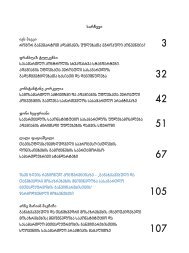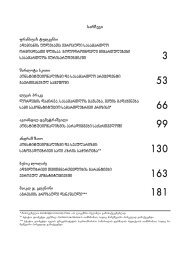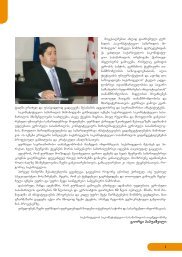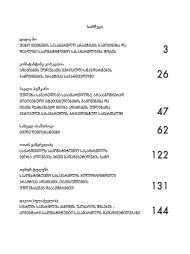Contents - Constitutional Court of Georgia
Contents - Constitutional Court of Georgia
Contents - Constitutional Court of Georgia
You also want an ePaper? Increase the reach of your titles
YUMPU automatically turns print PDFs into web optimized ePapers that Google loves.
Kononov v. Latvia<br />
four people (three <strong>of</strong> whom were women) perished in the flames. In all, nine villagers were killed:<br />
six men – five executed and one killed in the burning buildings – and three women – one in the final<br />
stages <strong>of</strong> pregnancy. The villagers killed were unarmed; none attempted to escape or <strong>of</strong>fered any<br />
form <strong>of</strong> resistance.<br />
According to the applicant, the victims <strong>of</strong> the attack were collaborators who had delivered a<br />
group <strong>of</strong> 12 Partisans into the hands <strong>of</strong> the Germans some three months earlier. The applicant said<br />
that his unit had been instructed to capture those responsible so that they could be brought to trial.<br />
He further claimed that he had not personally led the operation or entered the village.<br />
In July 1998 the Centre for the Documentation <strong>of</strong> the Consequences <strong>of</strong> Totalitarianism (Totalitārisma<br />
seku dokumentēšanas centrs), based in Latvia, forwarded an investigation file concerning the events<br />
<strong>of</strong> 27 May 1944 to the Latvian Principal Public Prosecutor. Subsequently, Mr Kononov was charged<br />
with war crimes.<br />
On 30 April 2004 the Criminal Affairs Division <strong>of</strong> the Supreme <strong>Court</strong> ultimately found the applicant<br />
guilty <strong>of</strong> war crimes under Article 68-3 <strong>of</strong> the 1961 Criminal Code <strong>of</strong> the Soviet Socialist Republic<br />
<strong>of</strong> Latvia (the “1961 Latvian Criminal Code”) 2 . Relying mainly on the provisions <strong>of</strong> the Geneva<br />
Convention relative to the Protection <strong>of</strong> Civilian Persons in Time <strong>of</strong> War (“Geneva Convention (IV)<br />
1949”), it convicted the applicant for the ill-treatment, wounding and killing <strong>of</strong> the villagers, finding<br />
in particular that burning a pregnant woman to death violated the special protection afforded<br />
to women during war. Furthermore, the applicant and his unit had violated Article 25 <strong>of</strong> the Hague<br />
Regulations 1907 which forbade attacks against undefended localities, such as the villagers’ farm<br />
buildings. Under Article 23(b) <strong>of</strong> the same Regulations, the applicant was also convicted separately<br />
<strong>of</strong> treacherous wounding and killing, as he and his unit had worn German uniforms during the<br />
Mazie Bati operation. Noting that he was aged, infirm and harmless, the Latvian courts imposed an<br />
immediate custodial sentence <strong>of</strong> one year and eight months.<br />
The applicant lodged an unsuccessful appeal on points <strong>of</strong> law.<br />
COMPLAINTS, PROCEDURE AND COMPOSITION OF THE COURT<br />
The applicant complained, in particular, that the acts <strong>of</strong> which he had been accused had not, at<br />
the time <strong>of</strong> their commission, constituted an <strong>of</strong>fence under either domestic or international law.<br />
He maintained that, in 1944 as a young soldier in a combat situation behind enemy lines, he could<br />
2 The 1961 Criminal Code replaced the existing 1926 Criminal Code <strong>of</strong> Soviet Russia which had been introduced by decree in 1940 when<br />
Latvia became part <strong>of</strong> the Union <strong>of</strong> Soviet Socialist Republics (“USSR”).<br />
193






